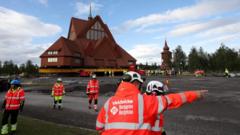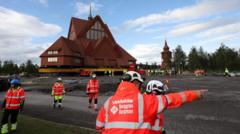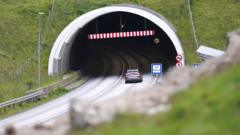As the Kiruna Church is relocated due to ground subsidence, local residents reflect on the profound emotional and cultural significance of this monumental event.
**Historic Church Relocation in Kiruna: A Community's Journey**

**Historic Church Relocation in Kiruna: A Community's Journey**
A 113-year-old church in Sweden's Kiruna embarks on a two-day move to safeguard its future amid mining threats.
In an extraordinary engineering feat, the iconic Kiruna Church, a 113-year-old landmark, is being transported 5 kilometers across the city of Kiruna, Sweden. The wooden structure, which has stood since 1912, faces an imminent threat from ground subsidence caused by prolonged iron ore mining activities. Moving at a cautious speed of 500 meters per hour, the two-day operation marks a significant moment in the city's ongoing relocation efforts.
Project manager Stefan Holmblad Johansson emphasized the meticulous planning undertaken to ensure the church's safe relocation. "It’s a historic event, and we don’t have a margin of error. Everything is under control," he stated, reflecting the years of preparation that have gone into this ambitious project. Since the mid-2010s, Kiruna has seen several historic buildings moved or demolished due to mining impacts, with this church move proving to be one of the most noteworthy.
Renowned as Sweden's most beautiful building predating 1950, Kiruna Church stands tall at 35 meters (115 feet) and weighs an impressive 672 tonnes. The mining giant LKAB, which operates the nearby iron ore mine and is Kiruna’s largest employer, is footing the bill for the relocation, estimated at around 10 billion Swedish krona (approximately $1 billion).
Rather than dismantle the edifice, engineers opted for a bold approach—transporting it intact on self-propelled modular transporters, supported by steel beams. As the church began its slow journey, extensive road modifications were necessary, including widening streets to accommodate the 24-meter (79-foot) building.
Among the complexities of the move is the careful preservation of the church’s interior treasures, including a significant altar painting by Prince Eugen. Johansson explained the challenges of protecting these delicate items during the transition, ensuring they remain stabilized and fully covered.
More than just an engineering marvel, the relocation carries deep emotional meaning for the community. Sofia Lagerlöf Määttä, a cultural strategist, noted how the church has served as a spiritual cornerstone for generations, evoking memories of personal and collective history. Vicar Lena Tjärnberg shared similar sentiments, expressing gratitude for the church’s move alongside the community despite the sorrow of leaving its original location.
As onlookers, including residents and Sweden's King Carl Gustaf, lined the route, this "slow TV" broadcast reveals how a community can adapt and persevere amid change. Ultimately, the relocation of Kiruna Church symbolizes not only the resilience of a town but also honors its rich history amidst the challenges posed by modern industry.





















